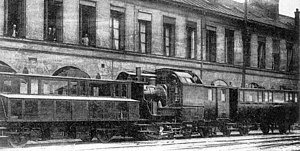Nord Voiture a vapeur
| Nord Voiture a vapeur | |
|---|---|
|
Steam multiple unit in front of the La Chapelle depot
|
|
| Numbering: | VV 4-11 |
| Quantity: | 8th |
| Manufacturer: | Buffaud & Robatel |
| Year(s): | 1908-1909 |
| Retirement: | 1932 |
| Type : | 2+A1+2n2t |
| gauge : | 1435 mm ( standard gauge ) |
| Length over buffer: | 26,710mm |
| starting traction: | 25kN |
| driving wheel diameter: | 1040mm |
| number of cylinders: | 2 |
| Cylinder diameter: | 250mm |
| piston stroke: | 320mm |
| Boiler length: | 2038mm |
| Boiler overpressure: | 14 bars |
| grate surface: | 0.72 m² |
| Radiant heating surface: | 3 m² |
| tubular heating surface: | 50.42 sqm |
| water supply: | 2,650m³ |
| fuel supply: | 1,150 tons of coal |
| Seats: | 1st class: 8 2nd class: 14 3rd class: 28 baggage carriages: 6 |
| standing room: | End platforms: 12 2nd class compartment: 6 3rd class compartment: 12 |
The Voitures à vapeur , abbreviated VV , of the Compagnie des chemins de fer du Nord ( Nord ) were eight steam multiple units used in suburban Paris services. They consisted of a locomotive framed by two passenger carriages. Because of their appearance, passengers referred to them as cages à poule , 'chicken coops' .
story
The Nord was looking for a vehicle that could run between any stations without a large infrastructure. In particular, no turntables and no bypass tracks in the stations should be necessary for operation, and operating costs should also be kept as low as possible. The multiple units were put into operation in 1908 after no more trains from the small Ringbahn ended at the Gare du Nord . The Nord multiple units shuttled between the Gare du Nord and La Chapelle-Saint Denis station on the Ringbahn, connecting it to the Gare du Nord. During World War I , only one train ran every hour between 5 a.m. and 7 p.m. The multiple units ran between the Gare du Nord and the small ring road until 1932.
The multiple unit was shown at the world exhibitions in Brussels in 1910 and in Turin in 1911 .
technology
The multiple units consisted of three parts: a leading carriage with a 1st and 2nd class compartment , the locomotive with a luggage compartment in the middle and the following 3rd class carriage. So that the driver's line of sight was not restricted, the car bodies of the passenger carriages were designed asymmetrically, with the left side in the direction of travel being lowered so that it did not obstruct the driver's view of the signals. The cars had a longitudinal aisle in the middle and longitudinal benches on the right-hand side in the direction of travel. On the lower side were locked payload compartments with lattice doors. This was to prevent passengers from being obstructed by luggage in the rather small passenger compartment. The carriages were equipped with a hot water heater, the water from which was heated by the boiler of the steam locomotive.
The composition offered a total of 56 seats and 30 standing places. There were eight seats in 1st class, 14 in 2nd class and 28 in 3rd class. A further six 3rd class seats could be temporarily offered in the luggage compartment of the locomotive.
See also
literature
- Félix Sartiaux, J Koechlin: The nouvelle voiture automobile à vapeur de la Compagnie des Chemins de fer du Nord . In: Revue generale des chemins de fer et des tramways . 27, 1st semester, no. 1 , January 1904, p. 11–19 ( bnf.fr ).
- Voiture automobile à vapeur de la Compagnie des Chemins de fer du Nord . In: Exposition universal. 1911. Turin (ed.): Exposition international des industries et du travail de Turin 1911. Groupe VII. Classes 39 et 40. Industrie des Transports. - Chemins de fer et tramways. 1911, p. 97–100 ( cnam.fr ).
web links
itemizations
- ^ a b Petite Ceinture Info: Les automotrices à vapeur de la Compagnie du Nord. December 23, 2021, retrieved December 23, 2021 (French).
- ↑ A. Bucher: The railway system at the world exhibition in Brussels 1910. In: Polytechnisches Journal . tape 326 , 1911, p. 22-26 ( hu-berlin.de - bottom line in Table 2).
- ↑ Universal Exposition 1911
- ↑ Exposition universale, p. 99
- ↑ Exposition universale, p. 98


